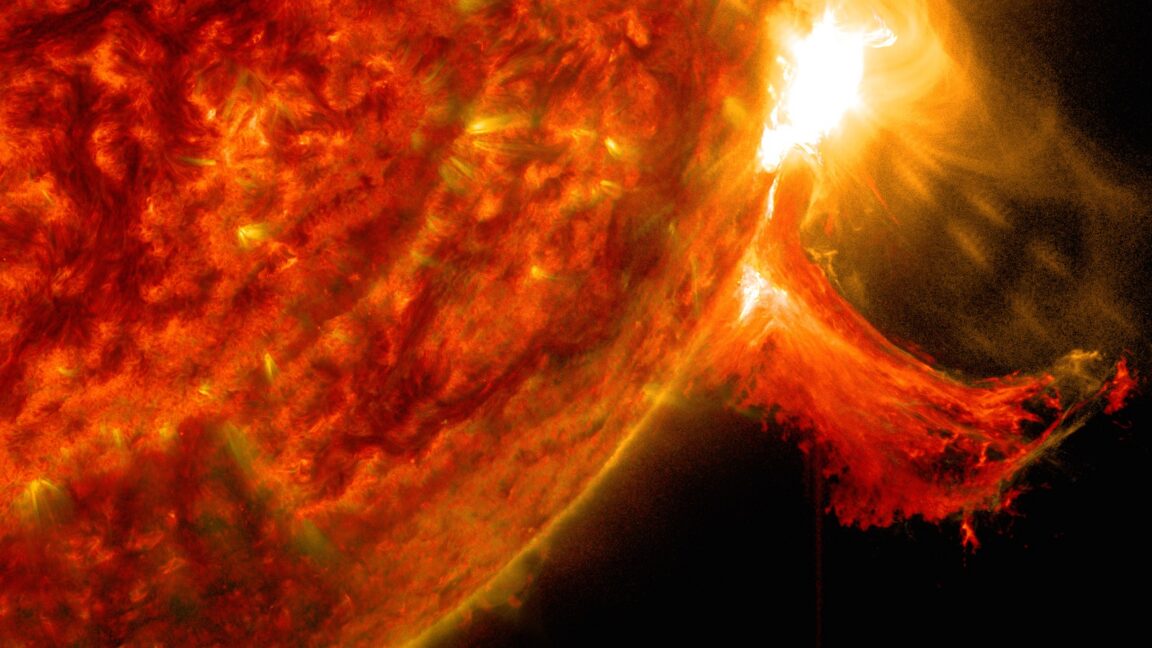Copyright Ars Technica

CAPE CANAVERAL, Florida—The second flight of Blue Origin’s New Glenn rocket was postponed again Wednesday as a supercharged wave of magnetized plasma from the Sun enveloped the Earth, triggering colorful auroral displays and concerns over possible impacts to communications, navigation, and power grids. Solar storms like the one this week can also affect satellite operations. That is the worry that caused NASA to hold off on launching a pair of science probes from Cape Canaveral Space Force Station, Florida, on Wednesday aboard Blue Origin’s New Glenn rocket. In a statement, Blue Origin said NASA, its customer on the upcoming launch, decided to postpone the mission to send the agency’s two ESCAPADE spacecraft on a journey to Mars. “New Glenn is ready to launch,” Blue Origin wrote on X. “However, due to highly elevated solar activity and its potential effects on the ESCAPADE spacecraft, NASA is postponing launch until space weather conditions improve. We are currently assessing opportunities to establish our next launch window based on forecasted space weather and range availability.” Blue Origin is the space company founded by billionaire Jeff Bezos. The heavy-lift New Glenn rocket is set to lift off on its second flight, and Blue Origin will attempt to recover the rocket’s reusable first stage booster on a landing platform in the Atlantic Ocean. This doesn’t happen often It’s unusual, but not unprecedented, for officials to postpone a rocket launch due to space weather. The launch of an Antares cargo rocket heading to the International Space Station was delayed one day in 2014 because of heightened solar activity. SpaceX held up the launch of a Falcon 9 rocket for several hours in 2023 to wait for space radiation levels to abate. This followed the loss of nearly 40 Starlink Internet satellites in 2022 as a geomagnetic storm caused the temporary expansion of Earth’s atmosphere, subjecting the low-altitude satellites to air resistance that pulled them out of orbit. Atmospheric drag is not the concern with the launch of NASA’s ESCAPADE mission because the satellites are heading into deep space. Instead, there is a risk that high-energy particles coming from the Sun might interfere with electronic systems on the twin probes. The ESCAPADE mission itself is designed to study the interaction between the solar wind and the upper atmosphere of Mars. Blue Origin did not immediately set a new target launch date for the ESCAPADE mission. Several launches are already scheduled to depart from Cape Canaveral in the next few days, including United Launch Alliance’s Atlas V rocket and a pair of SpaceX Falcon 9s. If those schedules hold, the next opening for New Glenn and ESCAPADE may not come until the weekend. A series of eruptions from the Sun, known as coronal mass ejections, sparked dazzling auroral light shows Tuesday night. The eruptions sent a blast of material from the Sun, including charged particles with a strong localized magnetic field, toward the Earth at more than 1 million mph, or more than 500 kilometers per second. Satellites detected the most recent strong coronal mass ejection, accompanied by a bright solar flare, early Tuesday. It was expected to arrive at Earth on Wednesday. “We’ve already had two of three anticipated coronal mass ejections arrive here at Earth,” said Shawn Dahl, a forecaster at NOAA’s Space Weather Prediction Center in Boulder, Colorado. The first two waves “packed quite a punch,” Dahl said, and were “profoundly stronger than we anticipated.” The storm sparked northern lights that were visible as far south as Texas, Florida, and Mexico on Tuesday night. Another round of northern lights might be visible Wednesday night. The storm arriving Wednesday was the “most energetic” of all the recent coronal mass ejections, Dahl said. It’s also traveling at higher speed, fast enough to cover the 92 million-mile gulf between the Sun and the Earth in less than two days. Forecasters predict a G4 level, or severe, geomagnetic storm Wednesday into Thursday, with a slight chance of a rarer extreme G5 storm, something that has only happened once in the last two decades. The sudden arrival of a rush of charged particles from the Sun can create disturbances in Earth’s magnetic field, affecting power grids, degrading GPS navigation signals, and disrupting radio communications. A G4 geomagnetic storm can trigger “possible widespread voltage control problems” in terrestrial electrical networks, according to NOAA, along with potential surface charging problems on satellites flying above the protective layers of the atmosphere. It’s not easy to predict the precise impacts of a geomagnetic storm until it arrives on Earth’s doorstep. Several satellites positioned a million miles from Earth in the direction of the Sun carry sensors to detect the speed of the solar wind, its charge, and the direction of its magnetic field. This information helps forecasters know what to expect. “These types of storms can be very variable,” Dahl said.



